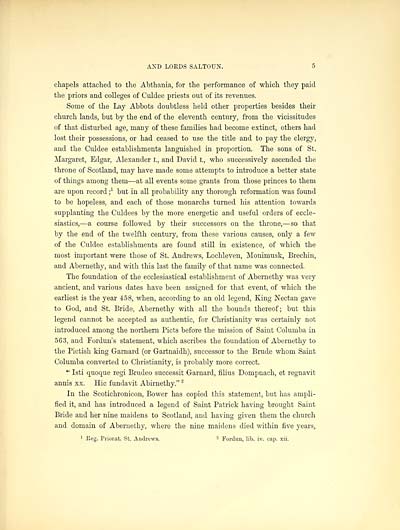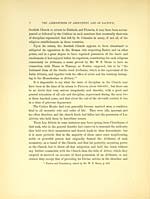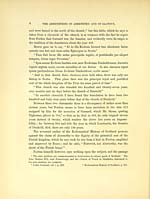Frasers of Philorth > Volume 2
(17)
Download files
Complete book:
Individual page:
Thumbnail gallery: Grid view | List view

AND LORDS SALTOUN. 5
chapels attached to the Abthania, for the performance of which they paid
the priors and colleges of Culdee priests out of its revenues.
Some of the Lay Abbots doubtless held other properties besides their
church lands, but by the end of the eleventh century, from the vicissitudes
of that disturbed age, many of these families had become extinct, others had
lost their possessions, or had ceased to use the title and to pay the clergy,
and the Culdee establishments languished in proportion. The sons of St.
Margaret, Edgar, Alexander I., and David I., who successively ascended the
throne of Scotland, may have made some attempts to introduce a better state
of things among them — at all events some grants from those princes to them
are upon record j 1 but in all probability any thorough reformation was found
to be hopeless, and each of those monarchs turned his attention towards
supplanting the Culdees by the more energetic and useful orders of eccle-
siastics, — a course followed by their successors on the throne, — so that
by the end of the twelfth century, from these various causes, only a few
of the Culdee establishments are found still in existence, of which the
most important were those of St. Andrews, Lochleven, Monimusk, Brechin,
and Abernethy, and with this last the family of that name was connected.
The foundation of the ecclesiastical establishment of Abernethy was very
ancient, and various dates have been assigned for that event, of which the
earliest is the year 458, when, according to an old legend, King Nectan gave
to God, and St. Bride, Abernethy with all the bounds thereof; but this
legend cannot be accepted as authentic, for Christianity was certainly not
introduced among the northern Picts before the mission of Saint Columba in
563, and Fordun's statement, which ascribes the foundation of Abernethy to
the Pictish king Garnard (or Gartnaidh), successor to the Brude whom Saint
Columba converted to Christianity, is probably more correct.
" Isti quoque regi Brudeo successit Garnard, films Dompnach, et regnavit
annis xx. Hie fundavit Abirnethy." 2
In the Scotichronicon, Bower has copied this statement, but has ampli-
fied it, and has introduced a legend of Saint Patrick having brought Saint
Bride and her nine maidens to Scotland, and having given them the church
and domain of Abernethy, where the nine maidens died within five years,
1 Reg. Priorat. St. Andrews. 2 Fordim, lib. iv. cap. xii.
chapels attached to the Abthania, for the performance of which they paid
the priors and colleges of Culdee priests out of its revenues.
Some of the Lay Abbots doubtless held other properties besides their
church lands, but by the end of the eleventh century, from the vicissitudes
of that disturbed age, many of these families had become extinct, others had
lost their possessions, or had ceased to use the title and to pay the clergy,
and the Culdee establishments languished in proportion. The sons of St.
Margaret, Edgar, Alexander I., and David I., who successively ascended the
throne of Scotland, may have made some attempts to introduce a better state
of things among them — at all events some grants from those princes to them
are upon record j 1 but in all probability any thorough reformation was found
to be hopeless, and each of those monarchs turned his attention towards
supplanting the Culdees by the more energetic and useful orders of eccle-
siastics, — a course followed by their successors on the throne, — so that
by the end of the twelfth century, from these various causes, only a few
of the Culdee establishments are found still in existence, of which the
most important were those of St. Andrews, Lochleven, Monimusk, Brechin,
and Abernethy, and with this last the family of that name was connected.
The foundation of the ecclesiastical establishment of Abernethy was very
ancient, and various dates have been assigned for that event, of which the
earliest is the year 458, when, according to an old legend, King Nectan gave
to God, and St. Bride, Abernethy with all the bounds thereof; but this
legend cannot be accepted as authentic, for Christianity was certainly not
introduced among the northern Picts before the mission of Saint Columba in
563, and Fordun's statement, which ascribes the foundation of Abernethy to
the Pictish king Garnard (or Gartnaidh), successor to the Brude whom Saint
Columba converted to Christianity, is probably more correct.
" Isti quoque regi Brudeo successit Garnard, films Dompnach, et regnavit
annis xx. Hie fundavit Abirnethy." 2
In the Scotichronicon, Bower has copied this statement, but has ampli-
fied it, and has introduced a legend of Saint Patrick having brought Saint
Bride and her nine maidens to Scotland, and having given them the church
and domain of Abernethy, where the nine maidens died within five years,
1 Reg. Priorat. St. Andrews. 2 Fordim, lib. iv. cap. xii.
Set display mode to:
![]() Universal Viewer |
Universal Viewer | ![]() Mirador |
Large image | Transcription
Mirador |
Large image | Transcription
Images and transcriptions on this page, including medium image downloads, may be used under the Creative Commons Attribution 4.0 International Licence unless otherwise stated. ![]()
| Histories of Scottish families > Frasers of Philorth > Volume 2 > (17) |
|---|
| Permanent URL | https://digital.nls.uk/96570460 |
|---|
| Attribution and copyright: |
|
|---|---|
| Description | A selection of almost 400 printed items relating to the history of Scottish families, mostly dating from the 19th and early 20th centuries. Includes memoirs, genealogies and clan histories, with a few produced by emigrant families. The earliest family history goes back to AD 916. |
|---|

